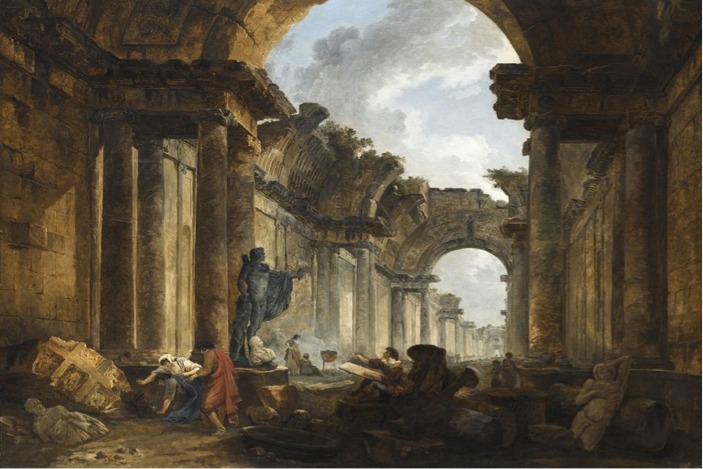View of the Grande Galerie in Ruins (1796)

Hubert Robert, View of the Grande Galerie in Ruins, 1796, oil on canvas (Louvre Museum, Paris, France)
Robert’s View of the Grande Galerie in Ruins (1796) is an oil on canvas capriccio measuring 114 x 146 centimeters. It depicts the Grande Galerie of the Louvre in a complete state of ruin. Robert uses a one-point perspective here, with the Galerie opening toward the viewer. Most of the ceiling has caved in, giving way to a large open view of the sky. Various plants and ferns have grown on top of what is left of the roof and the walls of the Galerie show signs of dirt and decay, having been exposed to the elements. Many of the works of art in the Galerie lay scattered and strewn across the floor, Michelangelo’s Dying Slave lies broken and abandoned in the right foreground. Various individuals navigate the ruined space, looking at broken works of art, talking casually to one another, and even burning wood under a large pot. Not a single painting remains on the walls.
In the middle of it all, a young man sits on a pile of ruins with a large sketchbook on his lap. He is drawing the only work that is left standing (and completely unharmed) in the Galerie, the bronze statue of Apollo Belvedere, which contemporary viewers would have immediately recognized. Johann Joachim Winckelmann (1717-1768), whom many consider the father of art history, described the work as “the highest ideal of art among all the works of antiquity that have escaped its destruction,” in his widely read publication, History of the Art of Antiquity.1 The statue itself was located in Rome at the time, not Paris, another indication that Robert’s painting is a capriccio.
The painting exhibits Robert’s ability to deliver a relevant and timely message through his imaginative landscapes. He depicts the Grande Galerie in a near hopeless state with most of its artworks completely ruined and its structural foundations in shambles. Yet, at the very center of the composition, Robert inserts a young painter, unaware of and unaffected by the scene of destruction around him. He gazes up at the statue of Apollo, a poignant and well-known representative of classical male beauty, his arm poised and ready to draw. Here, Robert alludes to the culture of antiquarianism in the eighteenth-century that resulted from the archaeological rediscovery of classical artifacts. Robert, having spent his early years on the Grand Tour in Rome, was indoctrinated in the values of classical learning and surely would have taken part in this neoclassical movement. He therefore depicts the outstretched arm of the statue beckoning toward young man, who in turn reaches out toward the statue, mirroring its gesture. Despite the catastrophic ruins around him, the young man continues to draw and find intellectual refuge in the antique statue; his attentiveness to the work brings a sense of hopefulness to the painting. Robert’s message is clear – even in the face of adversity and ruin, recovery and resurgence are possible if one is unwavering and confident in classical ideals.
1Johann Joachim Winckelmann, History of the Art of Antiquity, trans. Harry Francis Mallgrave (Los Angeles, CA: Getty Research Institute, 2006), 333.